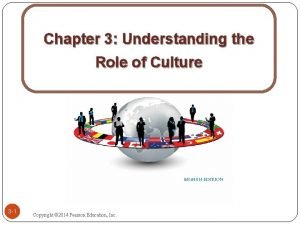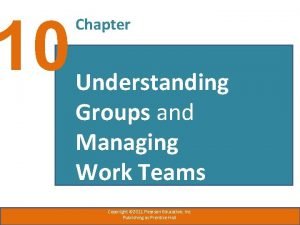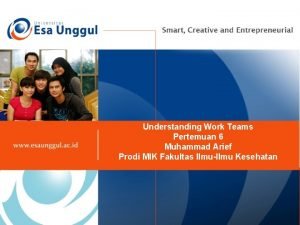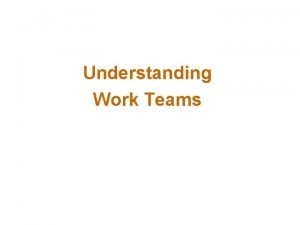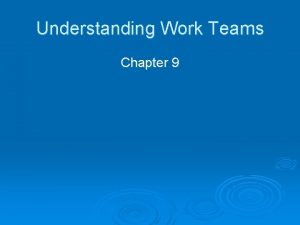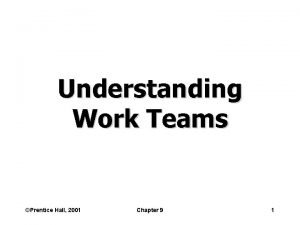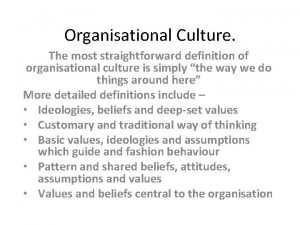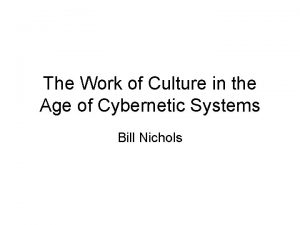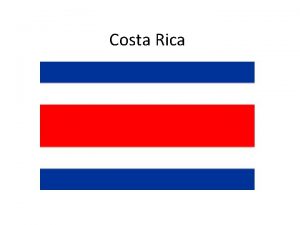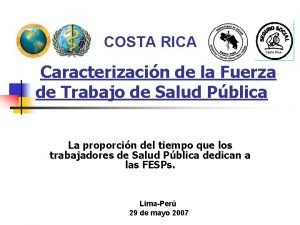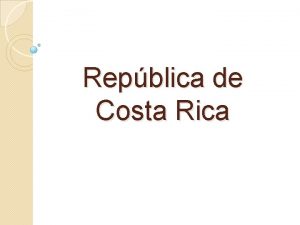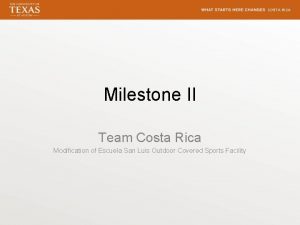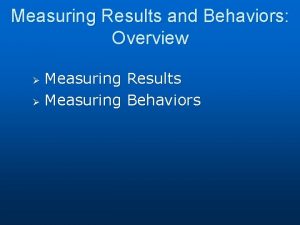Work place culture Measuring and understanding Prof Rica






























- Slides: 30

Work place culture Measuring and understanding Prof Rica Viljoen

Layout of presentation How to achieve sustainable organisational transformation through Inclusivity § Introduction § Transformation § Theory on Engagement and Inclusivity § Unleashing tacit potential in systems § Benefits of Inclusivity § Benchmark of Engagement (Be. Q) § Case study: Ghana, Australia, South Africa § How to create Engagement in organisations § Conclusions § Questions

Topic Description Sustainable Organisational Change through Inclusivity In today’s competitive, ever changing world, companies strive harder than ever to implement strategy in a sustainable manner and to stay recent in the mind of the global consumer. Leaders in organisations should understand the art of facilitating employee engagement, thus unleashing the energy in the system to perform. Inclusivity is a radical organisational methodology that can be used to facilitate sustainable organisational transformation.

Inclusivity Defined “…a radical organisational transformational methodology which aligns the doing and the being side of the organisation around commonly defined principles and values, co-created by all. It is a systemic approach that focuses on underlying beliefs and assumptions and challenges patterns in the individual, group and organisational psyche, to spend energy and engage in a sustainable, inclusive manner with the purpose to achieve shared consciousness. ”

Sustainability thorough Inclusivity - energy on all dimensions Organisational Transformation through Inclusivity EQ Journey Dialoguing Storytelling Group State Engagement Trait Engagement Behavioral Engagement Leadership Work attributes Organisational Leadership Trust Individual OD Interventions Appreciative Inquiry World Cafe The What Doing Leadership How individuals change The Individual Context: Industry South Africa Global Inclusivity The Team Being How groups change Engagement Apathy The Organisation Disconne ct How organisations change The way: How we change Why we change New world of work Essence of Change New Sciences Nature of the world We change differently Consciousness

Studying culture in mining Total: More than 50000 122 223 136 239 2907 393 1997 1693 302 2540 894 2237 3890

Engagement Defined Employee Engagement is defined (Corporate Leadership Council, 2004: 3) as the “positive emotional connection to an employee’s work, thus affective, normative and continuance commitment” and "a heightened emotional connection that an employee feels for his or her organisation, that influences him or her to exert greater discretionary effort to his or her work".

Engagement Defined Viljoen (2008) defined Engagement as “Engagement, the systemic result of the interplay between the individual potential, group potential and organisational potential in the context of the specific industry or national culture”. “as the output of the energy in the system to perform. ” The I-engage define behavioural engagement as defined by Macey (2008)

Business Case for Engagement The business case of Employee engagement • Companies with high levels of employee engagement improved 19. 2% in operating income while companies with low levels of employee engagement declined 32. 7% (Towers Watson). • If organisations increased investment in a range of good workplace practices which relate to engagement by just 10%, they would increase profits by $2, 400 per employee per year (IES/Work Foundation Report). • Increased employee engagement was accompanied by a 12% increase in stakeholder satisfaction and significant double‐digit revenue and margin growth over the past three years (Serco Study). • Engaged organisations grew profits as much as three times faster than their competitors. They report that highly engaged organisations have the potential to reduce staff turnover by 87% and improve performance by 20%. (Corporate Leadership Council) 9

Understanding the underlying beliefs in a system Understanding underlying beliefs in the system

Building sustainable architecture Building sustainable businesses Vicious Cycle: Disengagement Absenteeism Staff Turnover Apathy Low morale Negative Behaviour Poor service delivery Incidents and accidents Disconnected 30%-44% Virtuous Cycle: Unleashing voice Productivity Staff Retention Employee Satisfaction Creativity / Innovation Value based behaviour Customer Experience Safe behaviour Stakeholder Experience Apathetic 45 -59% Involved 60 -74% Engaged > 75% Re-wiring the organisation to have innate momentum to perform sustainably

Constructs for the Be. Q Within the context of the country: I-Engage We-Engage They-Engage Assumptions About Me Respect Self Regard Resilience Personal Responsibility Corporate Citizenship Assumptions About We Support Leadership Alignment, Valuing Diversity Accountability Assumptions About They Trust Business Orientation Adaptability to change Inclusivity Ethics

Benefits of Engagement Level of engagement Correlates directly to: + Productivity Abseetism Retention Turnover Employee Satisfaction Apathy Creativity and Innovation Number of incidents Safe Behaviour Number of Accidents Customer experience Mistakes Ability to deal with change Apathy

Human Capacity in the system to perform National Cultural The individual Assumptions About Me Assumptions Level of About engagement The We Team Organisation Assumptions About They and Society Context

National Cultural Diversity Human Orientation 100 80 60 Power Distance 40 100 20 80 0 South Africa 60 40 Peru Australia Ghana Rule Following 20 100 0 South Africa Peru Australia Ghana 80 60 Collectivism/Individualism 100 40 20 0 South Africa 80 Peru Australia Ghana Uncertainty Avoidance 60 40 100 20 80 0 South Africa Peru Australia Ghana 60 40 20 0 South Africa Peru Australia Ghana

Interrelatedness of African Purple Be. Q™ Laubscher’s Human Niches Family Relationships Elders Old ways People Relations Consultation Communication Harmony Animals Rules of Behaviour Secrecy Social Structure Copying Ceremonial/ Ritual Drumming, Dancing, Art, Storytelling Time Orientation Exists outside past or future Human Domain Stories Physical Domain Sacred/Spir itual Domain Animal Spirit Storytelling and Metaphors Ancestors Sky Sun, Moon, Stars and Wind Land Gift of gods Sacred earth White/Blac k Magic Sangomas Foresight Healing Honoring and Protection 16

Be. Q™ Laubscher’s Human Niches Dr. Graves's Emergent, Cyclical Levels of Existence Theory Applied Exists outside past or future Consultation Communication Harmony Storytelling and Metaphors Animal Spirit 53 % 18 % 20 % 6 % 3 % Sun, Moon, Stars and Wind Gift of gods Sacred earth 17

Drivers of Engagement The Ghana formula: Drivers of I-Engage

The Doing and The Being The soil needs the seed and the seed needs the soil One only has meaning with the other. The same thing happens to human beings. When male knowledge comes together with female transformation, then the great magical union takes place, which is called Wisdom. Paulo Coelho

Behaviour Based Safety Beliefs Shifts in underlying behaviour based safety beliefs Tarkwa Comparative Underlying Safety Belief Shifts Taking risks is valued 34. 70 59. 41 76. 5 78 86. 29 82. 70 It is important to follow rules 73. 1 59. 8 95. 21 90. 47 I am personally responsible for my own safety 84. 7 91. 7 It is difficult to do the right thing if no one is watching 37. 51 76. 00 54. 3 60. 6 2009 2010 2011 2012 0 10 20 my own 30 It is difficult to do the right thing if no I am personally responsible for one is watching safety 60. 6 91. 7 54. 3 84. 7 76. 00 90. 47 37. 51 95. 21 40 50 60 It is important to follow rules 59. 8 73. 1 82. 70 86. 2942233225414 70 80 90 Taking risks is valued 78 76. 5 59. 41 34. 7 100

I-engage formula Quantitative statistical analysis Factor analysis and regression Ghana_I-ENGAGE = =. 26*TEAMWORK (INTRA AND INTER TEAM)+ 24*SUPERVISION+. 18*RESPECT +. 13*BEING CONSULTED+. 11* TRUST +. 2 Australia I-ENGAGE = 28*CONNECTION +. 21*SUPERVISOR SKILL (DOING AND BEING) +. 19*TEAMWORK +. 13*FAIRNESS +. 18 Peru ENGAGE =. 22*CARING +. 21*CONNECTION +. 17*ALIGNMENT (DOING) +. 15*LEADERSHIP EXAMPLE +. 15*SUPPORT +. 10 South Africa I_ENGAGE = =. 222*SUPPORT +. 151*DIVERSITY +. 130*SUPERVISION + 2. 342 21

Be. Q Narrative Told The Be. Q Narrative Told If you want to walk fast, walk alone; if you want to walk far, walk together Even stronger alignment & focus on Safety More willingness to persevere & commit due to increased opportunity to grow Higher intra and more inter-departmental teamwork & support Improved Performance Feedback provided Willingness to Develop/Improve skills to add more value Stronger drive to improve efficiencies & drive to align to values Evident Enablers Decreased self worth & self regard – low confidence (skill erosion impact) Perception that company is not responsive Loss of voice – don’t feel heard/consulted Low rewards Tolerance of underperformance – nepotism Inconsistent/unfair dept performance management practices Low supervisory soft skill – motivation, acknowledgement Low loyalty Outcome Compromisers Discrepant valuing between production & support roles Impacts on sustainable ability to perform over time Willing, yet frustrated & concerned system – please hear the concers we raise – we want to help Manifested Dynamic 22

I-engage formula Quantitative statistical analysis Factor analysis and regression Ghana I-ENGAGE = =. 26*TEAMWORK (INTRA AND INTER TEAM)+ 24*SUPERVISION+. 18*RESPECT +. 13*BEING CONSULTED+. 11* TRUST +. 2 Australia I-ENGAGE = 28*CONNECTION +. 21*SUPERVISOR SKILL (DOING AND BEING) +. 19*TEAMWORK +. 13*FAIRNESS +. 18 Peru I-ENGAGE =. 22*CARING +. 21*CONNECTION +. 17*ALIGNMENT (DOING) +. 15*LEADERSHIP EXAMPLE +. 15*SUPPORT +. 10 South Africa I-ENGAGE = =. 222*SUPPORT +. 151*DIVERSITY +. 130*SUPERVISION + 2. 342 23

Engaged! Mind the gap!!!!

To focus on: Global value based leadership for the future 1. Measure Engagement and determine ROI of interventions Through scientific diagnostic cultural sensitive longitudinal validated instruments 2. Release voice “The most important thing is not the script but the story” 3. Listen with your eyes closed “The best leader is the one who listens the best to the total organisation” 4. Speak in colours / frequencies Translate for understanding and human niche 5. Remember what made us successful in the first place “If you want to move forward, look back…” 6. Position the people agenda as part of any strategic conversation “Incorporate Safety, HR, Internal Branding and External Positioning strategies in line strategy” 7. Integrate “I would do anything for the simplicity at the other side of complexity”

Questions ?

References Agarwala, T. 2003, ‘Innovative human resource practices and organisational commitment: An empirical investigation’, International Journal of Human Resource Management, vol. 14, no. 2, pp. 175 -197. Allen, N. J. & Meyer, J. P. 1990, ‘The measurement and antecedents of affective, continuance and normative commitment to the organisation’, Journal of Occupational Psychology, vol. 63, pp. 1 -18. Angle, H. L. & Perry, J. L. 1986, ‘Dual commitment and labour- management relationship climates‘, Academy of Management Journal, vol. 29, no. 1, pp. 31 -50. Angle, H. L. & Perry, J. L. 1983, ‘Organisational commitment: Individual and organisational influences‘, Work and Occupations, vol. 10, no. 2, pp. 123 -146. Baruch, Y. & Winkelmann-Gleed, A. 2002, ‘Multiple commitments: A conceptual framework and empirical investigation on a Community Health Service Trust‘, British Journal of Management, vol. 13, pp. 337 -357. Benson, J. 1998, ‘Dual commitment: Contract workers in Australian manufacturing enterprises’, Journal of Management Studies, vol. 35, no. 3, pp. 355 -375. Bishop, J. W. Dow Scott, K. & Burroughs, S. M. 2000, ‘Support, commitment, and employee outcomes in a team environment’, Journal of Management, vol. 26, no. 6, pp. 1113 -1132. Blau, P. M. 1964, Exchange and Power in Social Life, Transaction Publishers, New Brunswick, New York.

References Chang, K. & Chelladurai, P. 2003, ‘Comparison of Part-time workers and Full-time workers: Commitment and citizenship behaviours in Korean sport organisations’, Journal of Sport Management, vol. 17, pp. 394 -416. Crabtree, S. 2005, ‘Engagement keeps the doctor away‘, Gallup Management Journal, January 13, pp. 1 -4. Deery, S. J. & Iverson, R. D. 1998, ‘Antecedents and consequences of dual and unilateral commitment: A longitudinal study‘, The University of Melbourne, Department of Management working paper number 1, January 1998. Echols, M. E. 2005, ‘Engaging employees to impact performance‘ Chief Learning Officer, February, pp. 44 -48. Eisenberger, R. Fasolo, P & Davis-La. Mastro, V. 1990, ‘Perceived organisational support and employee diligence, commitment and innovation‘, Journal of Applied Psychology, vol. 75, no. 1, pp. 51 -59. Eisenberger, R. Huntington. R. Hutchinson, S. & Sowa, D. 1986, ‘Perceived organisational support‘, Journal of Applied Psychology, vol. 71, no. 3, pp. 500 -507. Gouldner, A. W. 1960, ‘The norm of reciprocity. American Sociological Review, vol. 25, no. 2, pp. 165 -178. Greenfield. W. M. 2004, ‘Decision making and employee engagement‘, Employee Relations Today‘, Summer, pp. 13 -24. Gubman, E. 2004, ‘From engagement to passion for work: The search for the missing person‘, Human Research Planning, pp. 42 -46.

References Harter, J. K. Schmidt, F. L. & Hayes, T. L. 2002, ‘Business- unit- level relationship between employee satisfaction, employee engagement, and business outcomes: A meta analysis‘, Journal of Applied Psychology, vol. 87, no. 2, pp. 268 -279. Kahn, W. A. 1990, ‘Psychological conditions of personal engagement and disengagement at work‘, Academy of Management Journal, vol. 33, no. 4, pp. 692 -724. Luthans, F. & Peterson, S. J. 2002, ‘Employee engagement and manager self-efficacy: Implications for managerial effectiveness and development‘, Journal of Management Development, vol. 21, 5, pp. 376 -387. May, D. R. Gilson, R. L. & Harter, L. M. 2004, ‘The psychological conditions of meaningfulness, safety and availability and the engagement of the human spirit at work’, Journal of Occupational and Organizational Psychology, vol. 77, PP. 11 -37. Macey, W. H. & Schneider, B. 2008. ‘The meaning of employee engagement’ , Industrial and Organisational Psychology, vol, 1, pp 3 -30. Mc. Dade, S. & Mc. Kenzie, A. 2002, ‘Knowledge workers in the engagement equation’, Strategic HR Review, vol. 1, 4, pp. 34 -37. Meyer, J. P. & Allen, N. J. 1991, ‘A three component conceptualisation of organisational commitment’, Human Resource Management Review, vol. 1, pp. 61 -89.

References Mowday, R. T. Steers, R. M. & Porter, L. W. 1979, ‘The measurement of organizational commitment, Journal of Vocational Behaviour, vol. 14, pp. 224 -247. Mueller, C. W. Wallace, J. E. & Price, J. L. 1992, ‘Employee commitment: Resolving some issues‘, Work and Occupations, vol. 19, no. 3, pp. 211 -236. Porter, L. W. Steers, R. M. , Mowday, R. T. & Boulian, P. V. 1974, ‘Organizational commitment, job satisfaction, and turnover among psychiatric technicians’, Journal of Applied Psychology, vol. 59, no. 5, pp. 603 -609. Price, J. L. & Mueller, C. W. 1986, Handbook of organizational measurement, Pitman Publishing, INC, Massachusetts. Price, J. L. & Mueller, C. W. 1981, ‘A causal model of turnover for nurses‘, Academy of Management Journal, vol. 24, no. 3, pp. 543 -565. Robinson, D. , Perryman, S. & Hayday, S. 2004, ‘The drivers of employee engagement‘, Institute of Employment Studies, Report 405. Viljoen, R. C. 2008, ‘Sustainable organisational transformation through inclusivity’, DBL dissertation. Available online www: //etd. unisa. ac. za/ETD-db/theses/available/etd-02192009090759/unrestricted/00 thesis. pdf
 Millions billions trillions chart
Millions billions trillions chart Understanding the role of culture
Understanding the role of culture Non material culture definition
Non material culture definition Batch culture vs continuous culture
Batch culture vs continuous culture Indian vs american culture
Indian vs american culture Stroke culture method
Stroke culture method Folk culture and popular culture venn diagram
Folk culture and popular culture venn diagram What is folk culture
What is folk culture Stroke culture method
Stroke culture method Folk culture and popular culture venn diagram
Folk culture and popular culture venn diagram Stroke culture method
Stroke culture method Carpet culture method
Carpet culture method Surface culture deep culture and esol
Surface culture deep culture and esol Understanding work teams
Understanding work teams Waves are repeating disturbances that transfer
Waves are repeating disturbances that transfer A disturbance that transfers energy from place to place.
A disturbance that transfers energy from place to place. Sociologists define a symbol as
Sociologists define a symbol as Batch culture vs continuous culture
Batch culture vs continuous culture Collectivistic cultures
Collectivistic cultures Vocational subculture
Vocational subculture Inert organizational culture
Inert organizational culture Quality culture changing hearts minds and attitudes
Quality culture changing hearts minds and attitudes The time and place
The time and place Teams typically outperform individuals
Teams typically outperform individuals Cross functional team
Cross functional team Understanding work teams
Understanding work teams Understanding work teams
Understanding work teams Chapter 4 work and energy section 1 work and machines
Chapter 4 work and energy section 1 work and machines Define work culture
Define work culture The work of culture in the age of cybernetic systems
The work of culture in the age of cybernetic systems Smart work and hard work
Smart work and hard work

